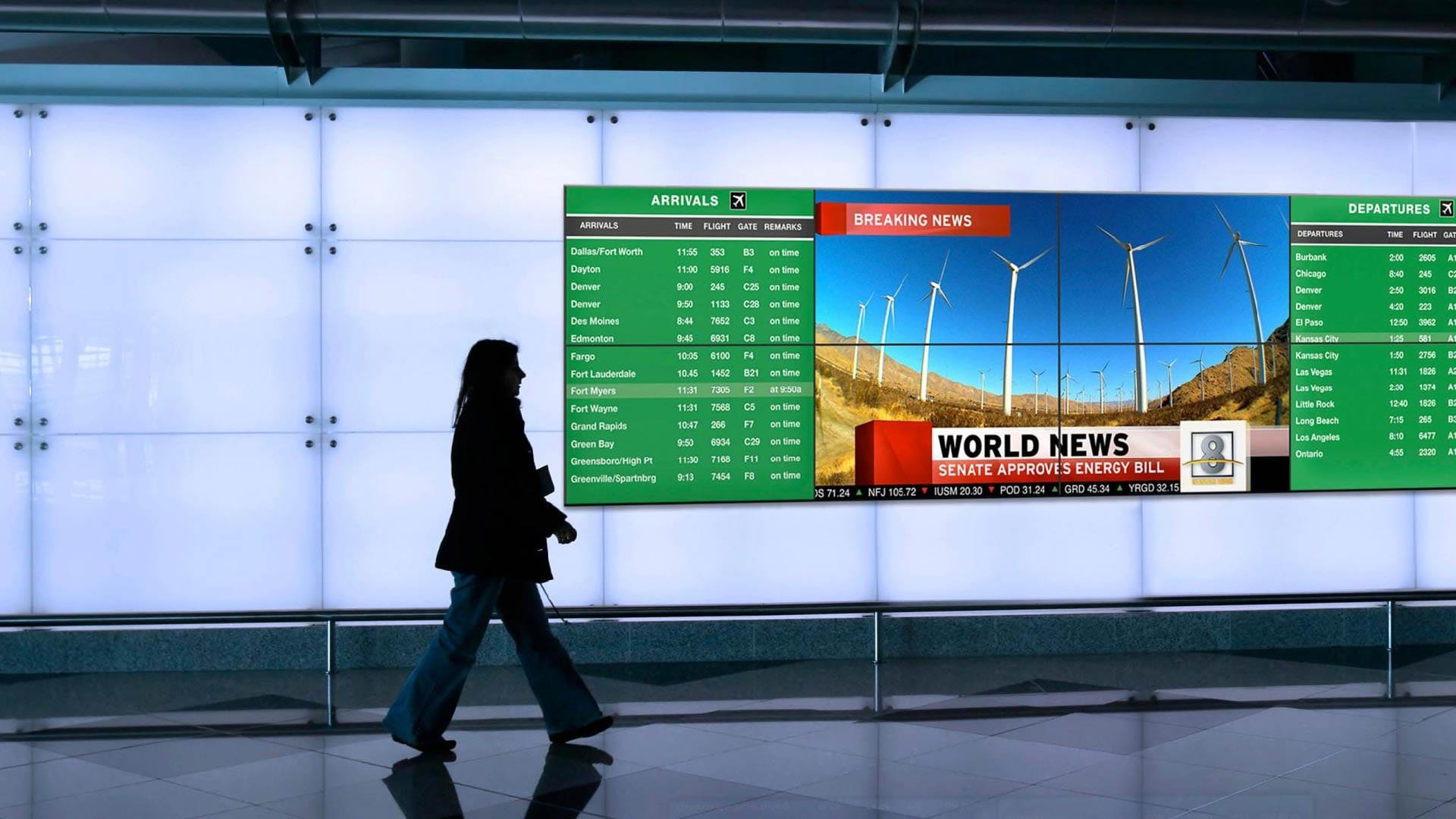Digital signage, which used to be in a state of simple signs and messages with only text content, has changed significantly over the last few years. The future of digital signage is today’s world made by advanced technologies, effective and refined content management, and the most engaging systems for businesses and their customers and clients. As the world goes more connected and smart the future trends of digital signage will be more personalized, interactive, and smart data usage. As we move forward in this article, let’s discuss further some of the trends, advancements, and prospects of digital signage.
1. Personalization and Targeted Content
Digital signage personalized will prove to be one of the most significant trends in the future. The current digital signage is not general and uniform; they are progressive and smart, providing the targeted audience with content that is relevant in terms of demography, geography and activity.
For instance, the digital signage solution that is powered by AI and facial recognition technology can determine the age, gender, and mood of the viewers. From these data points, the system can provide an individual or group advertisement or content that is relevant to the specific audience. This technology can be implemented to make the retailer’s screen display particular promotion to the young adult while another screen displays different content to the older person.
Moreover, GPS and mobile data in conjunction with digital signage will further improve geo-targeting attributes. The brands and businesses will incorporate these technologies to show the relevant offers or promotions based on the location of the user and therefore provide a very personalized experience.
2. Interactive and Touchless Engagement
Haptics has always been an integral part of digital signage and now, the trend will shift towards touchless haptic interaction due to hygiene issues and quick development of sensors and voice recognition technology.
The COVID-19 pandemic forced the use of touchless solutions that made technologies like gesture control and voice interaction popular. The systems enable users to engage content without having to touch the screens in a way that is safer and more efficient. Digital signage in the form of touchless systems for navigation, public information, and product engagement will continue to become standard in retail stores, transit centers, and public spaces.
However, it will be possible to install QR codes and mobile integration, it will enable users to switch on-off the signage from their smart phones, making it an even more interactive. This is especially so in the retail and hospitality industries, whereby consumers have the ability to scan a code and obtain specific details or have the ability to control the screen from a distance.
3. AI and Machine Learning in Content Optimization
Artificial intelligence and machine learning are two developing concepts that are slowly becoming critical components of digital signage. These technologies allow for immediate content modification based on the data received from consumers, market trends and conditions, as well as other factors.
The use of digital signage incorporating artificial intelligence will be able to choose what content to broadcast to the audience at any one time. For example, in the retail setting, digital signage can capture variables such as, footfalls, weather, or event, and adapt content. For instance, if a store records a high turnover on products in a certain category, the signs can alert or advertise, products in that category.
It also has the ability to forecast preferences and trends in the future so that companies can improve the effectiveness of using digital signs in the long run. Since AI is able to analyse the customers’ habits, it will be easy to determine when certain types of content should be posted to have the most significant impact on customers and achieve the intended conversion rates.
4. Integration with IoT (Internet of Things)
As more and more devices get connected to the web, we can expect the digital signage to be more connected and smarter. Since IoT identification enables the digital signage to be connected to other devices, it can collect data from the devices in real time, enabling more relevant content to be posted.
For example, a smart city environment can comprise digital display systems that interact with traffic signals, sensors, and public transportation. This combined network could show information about traffic, bus timetables or air pollution in real time. In retail, IoT integration makes it possible for digital signage to be integrated to smarter shelves or in-store beacons for highly targeted marketing.
In the future, the digital signage will be connected with other smart devices and objects in the IoT environment thus making them to exchange information. This will create even greater contextual delivery of content and will raise the bar on the customer experience.
5. Augmented Reality (AR) and Virtual Reality (VR) Integration
Another trend in digital signage is the use of augmented reality and virtual reality technologies in the work of digital signs. With AR-enhanced digital signage, users can engage with content that exist in both reality and augmented reality. This technology can be applied to the design of highly captivating and stimulating experiences which may command attention in a way that signages cannot.
For instance, in the retail space, AR signage may enable a customer to ‘’experience” a particular outfit without having to heading to the changing rooms. In entertainment and event spaces AR can enable users to play with models, games, or interactive adverts.
VR can also be incorporated into digital signage to help users to interact with and take them to another virtual world. This technology will benefit so many industries like the travel industry, estate and entertainment industries where a user can virtually make decisions by visiting a certain place, house or a product.
6. Green and Sustainable Signage Solutions
The topic of sustainability is gradually gaining importance in the world of commerce and customers. In response to this, the future of digital signage will be more inclined to using environmentally friendly products. Newer display technologies like OLEDs and E Ink are becoming more energy efficient and as such the energy consumption of digital signage systems is going to decrease.
In addition, solar digital signs are becoming more popular since they are now using solar panels in its production especially in outdoor settings that would benefit from this innovation. Furthermore, other business needs will be met by more efficient digital signage solutions that minimize the use of paper materials, which also corresponds to global trends in sustainability.
The improvements in the hardware design of digital signage will also stem from the use of recyclable material and sustainable manufacturing. In the future, as more companies pay attention to environmental conservation, there will be need to come up with environmental friendly signs that would be of benefit to the business and the environment.
7. 5G and Real-Time Data Streaming
The advancement in technology specifically 5G will be a game changer in digital signage through offering higher data transfer rates, lower latency, and live content streaming. In 5G environment, digital signage system can showcase high-definition content, live streaming and real time updates without any time lag or hang up.
This technology will be most beneficial in the contexts of sport facilities, entertainment centers, and transport nodes where the real-time information is most important. For example, in sports facilities, 5G can be used to create interactive billboards that show statistics, replay or social media interactions.
In addition, the enhanced bandwidth that is being offered by 5G will make the digital signage more capable of displaying more complex and interactive content such as the use of AR and VR.
8. Data Privacy and Security
Increasing the role of data in digital signage and making the advertising messages more individual, the question of personal data protection will become more acute. Future digital signage solutions will have to be designed around protecting the data and adhering to the regulation such as GDPR and CCPA.
Digital signage systems will generate vast amounts of data that must be protected from unauthorized access, using techniques such as encryption, anonymization, and secure data transmission. Besides, there is need to be open with consumers regarding the ways in which their data is collected and gain their permission this will be important aspects in creating trust and ensuring compliance to the laws on consumer privacy.
Conclusion
Based on this content, the future of digital signage is expected to be even more personalized, interactive and connected. As we see the development of AI, IoT, AR, and 5G, digital signage will continue to be an essential element in serving as the primary source of dynamic data-driven messages to the target market. Companies in all sectors will have to prepare for these changes by employing new, advanced technologies that will enable them to design and deliver more valuable and transformative customer experiences. That is why sustainability, security, and privacy will also remain important factors defining further development of digital signage and its integration into the overall concept of systems that should meet social and environmental goals.





